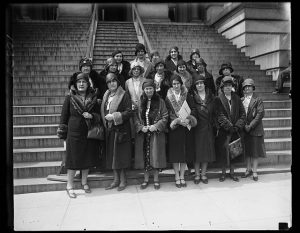After gaining the right to vote in 1920, white women were excited about the newly gained responsibilities within the Democratic and Republican party. [1] The New York Tribune article Women Who Are Playing a Part in the Political Game depicts the enthusiasm about some of their efforts to help further advance the campaigns of the presidential candidates.
To better understand the significance of women’s political involvement in the 1920s, it is crucial to consider the broader historical context. For much of history, women were denied fundamental rights, including voting, owning property, and participating in public life. The women’s suffrage movement, which gained momentum in the late 19th and early 20th centuries, was pivotal in changing these norms. [2] The impact of World War I cannot be overstated, as women’s contributions during the war challenged societal expectations and demonstrated their competence in traditionally male roles. [2] These efforts culminated in the ratification of the 19th Amendment, which not only secured voting rights for white women but also catalyzed their entry into other public arenas. However, the suffrage movement was marked by exclusions, particularly of Black women, and internal divisions among white women based on age and levels of radicalism. [1]
The article starts with the author declaring she hasn’t “seen such effusion and enthusiasm, such hero worship unashamed” since her days in college, as she did in the headquarters where women worked for various presidential candidates. She conveys her excitement about such tremendous shift for women and admiration for what great things they now do. The article describes some of the women’s involvement in the women’s suffrage movement, for example Harriet Vittum, Fletcher Dobyns, and Olive Stott, and illustrates their efforts to capitalize on the hard-won right to vote. For example, Olive Stott later led the National Association of Women Lawyers, emphasizing the enduring influence of these trailblazing women. The article also highlights Margaret Cumpacher, known as “The Mother of the Navy,” who showcased women’s contributions during World War I and beyond by volunteering as a Navy recruiter. In the center of the article is an illustration of the seven women who were significant for the presidential campaigns all over the United States. This leads us to infer that the women all over America were ecstatic to take on the power roles and utilize their strengths to help advance the society. The article’s enthusiasm matches the changes in the women’s literature at the time – feminism in its earliest form, a main character woman usually moving to a big city, like New York, to find her individual freedom and new work roles. [4] Most of the women talked about in the article have lived in New York or other big cities for most of their lives.

National Association Women Lawyers see President Hoover through four representatives, asking for United States Plenipotentiaries to the Hague to vote for a World Code of equality between men and women. Left to right, front row: Mrs. Olive Stott Gabriel, President, Mrs. James Garfield Riley, Dean Washington College of Law, Miss Laura Berrien, and Mrs. Bernita Shelton Matthews, Vice President of the Association [State, War and Navy Building, Washington, D.C.] [5]
Despite the author’s tone being enthusiastic and anticipatory, the article’s celebratory tone overlooks the persistent challenges women faced. According to later discoveries of social scientists, “many women at the time were still unable to contribute fully to American society – even after suffrage – because they have remained the oppressed victims of history.” [3] Because there was a period of historical neglect of the image and role of women in post-WWI, historians began to question its validity. [3] One concrete example of this was that in the 1920 elections, the same ones the New York Tribune article talks about, significantly less women than men had utilized the ballot [3], and those who did mostly voted unpredictably, possibly due to lack of political experience. Not many writers further followed women’s progress in navigating their economic and social roles. [3] Additionally, even in fictional pieces that served to inspire women, “not all men respected the New Woman’s independence, and some women themselves questioned whether or not the struggle was worthwhile” [4]. Furthermore, fictional portrayals of the “New Woman” in literature sometimes depicted blind rejection of tradition rather than meaningful engagement with modernity.⁴
While women’s participation in political campaigns was a groundbreaking step, it was just the beginning of a longer struggle for equality. The New York Tribune article captures the excitement of the moment, but it also invites reflection on the complexities of women’s evolving roles in public life. A statement that perfectly summarizes women’s role in political life, as highlighted in the article, is:
“Very few women want public office. But they want to have a share in selecting the men best fitted for office and most able to carry out the things in which they believe.”
By exploring this source, we gain insight into both the achievements and limitations of the women’s movement in the 1920s, a decade of both progress and ongoing challenges.
Works Cited
[1] Lynn Dumenil, “The New Woman and the Politics of the 1920s,” OAH Magazine of History 21, no. 3 (2007): 22–26, https://research.ebsco.com/linkprocessor/plink?id=f073120b-40ad-3b97-bd87-33d7c8688eea.
[2] David S. Emory, America: A Narrative History, Brief 12th ed. (New York: W.W. Norton & Co., 2022), 334.
[3] Estelle B. Freedman, “The New Woman: Changing Views of Women in the 1920s,” The Journal of American History 61, no. 2 (1974): 372–93, https://doi.org/10.2307/1903954.
[4] Maureen Honey, “Gotham’s Daughters: Feminism in the 1920s,” American Studies 31, no. 1 (1990): 25–40, http://www.jstor.org/stable/40642351.
[5] Library of Congress, Prints & Photographs Division. Unemployed Men Sitting on the Edge of a Car, Cedar Rapids, Iowa. 1938. Horydczak Collection. Accessed December 2, 2024. https://www.loc.gov/pictures/resource/hec.35760/.
